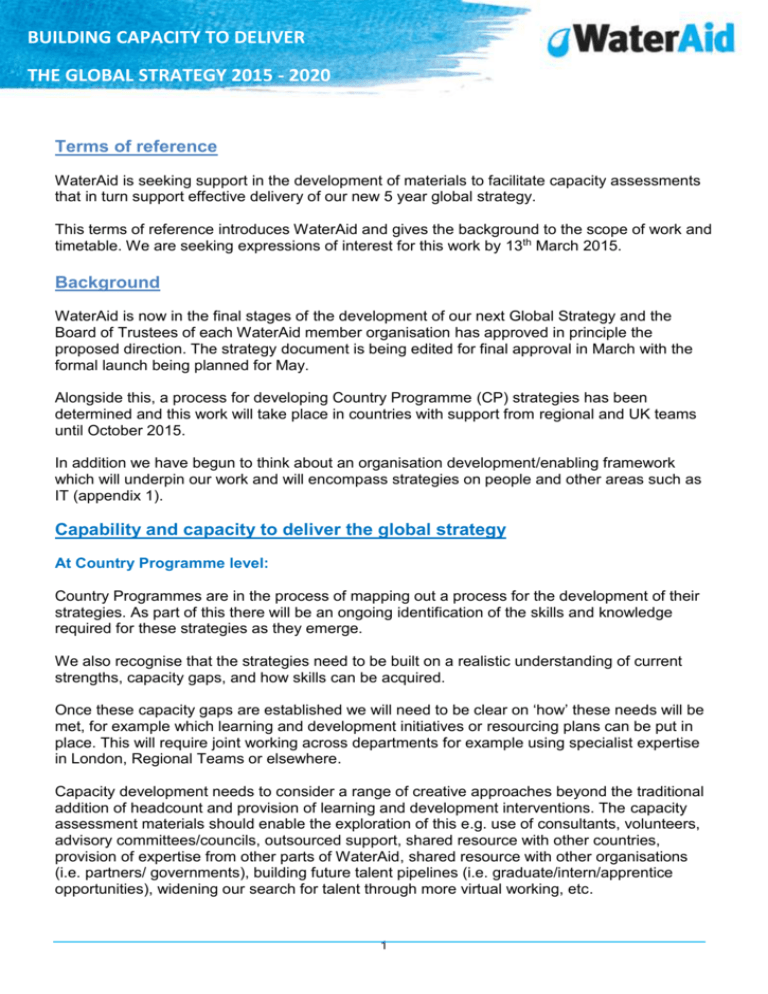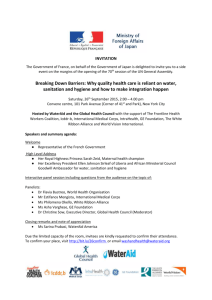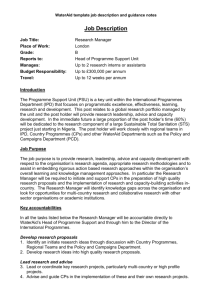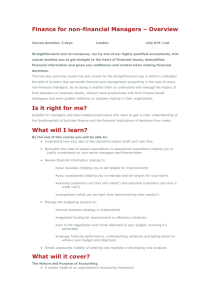ToR WaterAid
advertisement

BUILDING CAPACITY TO DELIVER THE GLOBAL STRATEGY 2015 - 2020 Terms of reference WaterAid is seeking support in the development of materials to facilitate capacity assessments that in turn support effective delivery of our new 5 year global strategy. This terms of reference introduces WaterAid and gives the background to the scope of work and timetable. We are seeking expressions of interest for this work by 13th March 2015. Background WaterAid is now in the final stages of the development of our next Global Strategy and the Board of Trustees of each WaterAid member organisation has approved in principle the proposed direction. The strategy document is being edited for final approval in March with the formal launch being planned for May. Alongside this, a process for developing Country Programme (CP) strategies has been determined and this work will take place in countries with support from regional and UK teams until October 2015. In addition we have begun to think about an organisation development/enabling framework which will underpin our work and will encompass strategies on people and other areas such as IT (appendix 1). Capability and capacity to deliver the global strategy At Country Programme level: Country Programmes are in the process of mapping out a process for the development of their strategies. As part of this there will be an ongoing identification of the skills and knowledge required for these strategies as they emerge. We also recognise that the strategies need to be built on a realistic understanding of current strengths, capacity gaps, and how skills can be acquired. Once these capacity gaps are established we will need to be clear on ‘how’ these needs will be met, for example which learning and development initiatives or resourcing plans can be put in place. This will require joint working across departments for example using specialist expertise in London, Regional Teams or elsewhere. Capacity development needs to consider a range of creative approaches beyond the traditional addition of headcount and provision of learning and development interventions. The capacity assessment materials should enable the exploration of this e.g. use of consultants, volunteers, advisory committees/councils, outsourced support, shared resource with other countries, provision of expertise from other parts of WaterAid, shared resource with other organisations (i.e. partners/ governments), building future talent pipelines (i.e. graduate/intern/apprentice opportunities), widening our search for talent through more virtual working, etc. 1 BUILDING CAPACITY TO DELIVER THE GLOBAL STRATEGY 2015 - 2020 A recent short capacity assessment was undertaken across CPs to support them in starting this thinking. This work will further build upon these initial assessments. We want to ensure we have a high performing environment that ensures every member of staff can do the best job possible. Therefore capacity assessments should also consider the ways of working necessary to deliver the strategy and achieve our mission. We want to be sure that we are not adding roles where better performance management, ensuring we have the right people in roles, the right integration and communication in and across teams, and addressing blockages in terms of ways of working, systems and processes will also increase capacity. At Global/ UK/ Regional level Capacity assessments and capacity building are also important at the level of Regional teams and WaterAid UK or other member teams (including teams based in London). In their planning these teams are considering the leadership and specialist input required of them by the organisation as a whole as well as the support that is needed of them by CPs. Their role in supporting Country Programmes may evolve as Country level strategies are developed. Team roles Name and job title Annette Gillingham – Head of Leadership and Engagement Veerinder Puri – Head of International People Management Fiona Lavery – Head of UK People Management Regional People Leads Country programme People and OD leads, where applicable Subject management experts – normally in regional teams or in London. Project consultant To be appointed Key responsibilities in this project Overall responsibility for the project and coordinating resources. Leading international capacity assessment and international resourcing implications Advising on UK implications Supporting CP capacity assessment Supporting CP capacity assessment See below Role of the project consultant We are seeking assistance with the assessment of our current capacity and future requirements at a global and country level. We anticipate that this will be to provide resources to help us assess: 1. The key skills and knowledge needed across the organisation (across different functional areas and also at Country Programme level) to implement the new global strategy. What are the skills and knowledge required? How many people do we need with these skills and knowledge and where do they need to be located? 2 BUILDING CAPACITY TO DELIVER THE GLOBAL STRATEGY 2015 - 2020 2. The current capacity of the organisation and also specifically at CP level. What skills do we have, how many people and where are they located. 3.’How’ will we meet the capacity gaps that we have at organisational level and also at CP level? For example, what learning and development initiatives may be required, what resourcing will be required and how will we find this talent, so that the strategies are realistic and are built on the capacity they have or are able to obtain. 4. A way of collating information on the skills and numbers of people needed to implement each CP strategy, so that it is clear the areas of capacity which will be required and met at CP level and what may need to be met in other parts of the organisation. This will be important for decision making and also to overall organisational resourcing and development initiatives. 5. What changes in behaviours, culture, working environment, structures may we require to deliver the new strategy. We are anticipating that some outcomes from this work would include: 1. Some facilitated sessions with the members of the People Team and also a small working groups of key staff around the organisation to provide ideas and context for the work and support its development. 2. Production of a session facilitation pack for Regional People Leads to use at appropriate stages of the CP strategy process, see appendix 2. This would likely be a session pack for a 1-2 day interactive workshop with each CP. The aim is that this is not a paper based skills audit which CPs would complete, but more a facilitated session which would evolve the thinking through discussion. This workshop would aim to support CPs to consider: What skills and knowledge they require to deliver the new strategy. What do they currently have in place How will they ensure they are able to meet these gaps over the next 5 years (practical steps) What changes do they need to make in terms of ways of working, culture, processes etc. Any changes required to their working environment or structure to support this and how 3. A session facilitation pack (or to run facilitated sessions) with subject matter experts on the people demands of the Global Strategy (for example with different functional teams) 4. A way of pulling the information together to inform global resourcing and learning and development strategies, including a set of templates to capture the information gathered across the organisation in a simplistic way. This should support WaterAid in developing a clear implementation plan at CP level (as part of their 5 year people plan) and an overarching plan as part of the People and OD Strategy. 3 BUILDING CAPACITY TO DELIVER THE GLOBAL STRATEGY 2015 - 2020 Other Considerations The importance of talent pipeline management/succession planning –to manage and retain our talent effectively and ensure we do not have vacancies in critical roles. Engagement and retention are also critical to ensure that we are getting maximum value from all our existing employees by harnessing discretionary effort, and that we are not wasting resources on recruiting into high numbers of vacancies. Big picture questions will also be important so we don’t get lost in the detail – e.g.: What are some of the enablers and blockers? What will help us to achieve our vision, or stop us from succeeding? What really makes things happen ‘on the ground’? Do we need an analysis of external resource pools? Personal qualities and behaviours are critical to success – eg Flexibility, Commitment, how will we ensure that these are given full weight in the analysis and plans? Keeping it future focussed – how clear will future be and when? (will require agility at individual and organisation level too?) How to incorporate and build on the CP assessments that have already taken place? See appendix 3 Proposed Timelines March 2015 Appoint consultant March - April Development of materials (including the facilitation packs for CPs) 2015 Tools and templates to be provided to Regional People Leads to support May CP strategy process. A session with the team on delivering these workshops May – Regional People Leads to work with CPs to establish needs and August capacity. Sessions with functional teams / subject matter experts to establish key global capacity areas. August A piece of work to pull this information together from CPs and other September functional teams Implementation October onwards 4 BUILDING CAPACITY TO DELIVER THE GLOBAL STRATEGY 2015 - 2020 Appendix 1: Draft global strategy enabling framework WaterAid’s Enabling Framework Our vision Our mission Our values Our enabling vision Governance & Strategy Systems & Technology Ways of Working Living our values IT Systems Planning Working in Partnership Measures of change Innovation, learning & knowledge building Effectiveness & impact though technology Governance Financial Strategy Internal processes being agile Ethical stewardship Risk / opportunity Management Environmental stewardship Organisational design Team working across a global organisation Internal communications 5 Our People Leadership People Management Engagement Skills and competencies BUILDING CAPACITY TO DELIVER THE GLOBAL STRATEGY 2015 - 2020 APPENDIX 2: Country Programme strategy development process Stage 1: Preparing to plan Stage 2: Reflection, analysis and visioning Stage 3: Visioning and definition of role and ToC Stage 4: Strategic choices and prioritisation Stage 5: Design of programmatic approach Stage 6: Developing a measurement framework Stage 7: Resource planning and implications Stage 8: Drafting, consultation and final approval Stage 2: Reflection, analysis and visioning People implications of SWOT analysis: What are our people strengths? Areas where we are well covered – e.g. management, technical, finance, people and OD, advocacy, fundraising etc What are our people weaknesses – gaps? Lack of capacity? What are the opportunities – working with partners, working with consultants, joining with other CP’s to share talent, support from Region or London teams, hiring people from a strong talent pool, What are the threats – competition in the talent pool, visa issues Stage 5: Design your programmatic approach: Based on the strategic choices we have made, what are the programmatic decisions made in terms of geographical location, resources, partnership etc.? What will our country programme look like in 5 years? Are there any necessary shifts and changes to our people – numbers, capabilities? Stage 7: Resource planning and organisational implications What is the level of growth that we expect to see in order for us to achieve our objectives? what people resources do we need to achieve our goals? Consider how you see your organisation structure and the skill sets required to deliver your strategy. Do we have the required skillset? What knowledge and people skills do we need? How will we develop these? 6 BUILDING CAPACITY TO DELIVER THE GLOBAL STRATEGY 2015 - 2020 APPENDIX 3: Short CP capacity assessment recently undertaken (with an example) Functional area A=4 B=3 C=2 Very High High Moderate Low Programmes: 3 D=1 Total points 3 Quality; E&I; Sustainability Integrated approach Policy & advocacy: 2 2 Strategic engagement; GAP 2 Regional / global links Grant management : 3 3 Proposal development; Donor comm.; Progress on plans; Reporting Reforecasting Finance : 2 2 2 2 Budget monitoring; Internal controls; Phasing; Reforecasting; Fin performance People: Recruitment prac; Staff engagement L’ship & mgmt dev; Addressing poor perf, conflict Total 12 A = 16 - 20 : Countries with very high capacities B = 11-15 : Countries with reasonably good capacities C = 6 – 10 : Countries with average capacities D=0–5: Countries with low capacities In this case, this country has scored 12 which puts it in category B. 7








